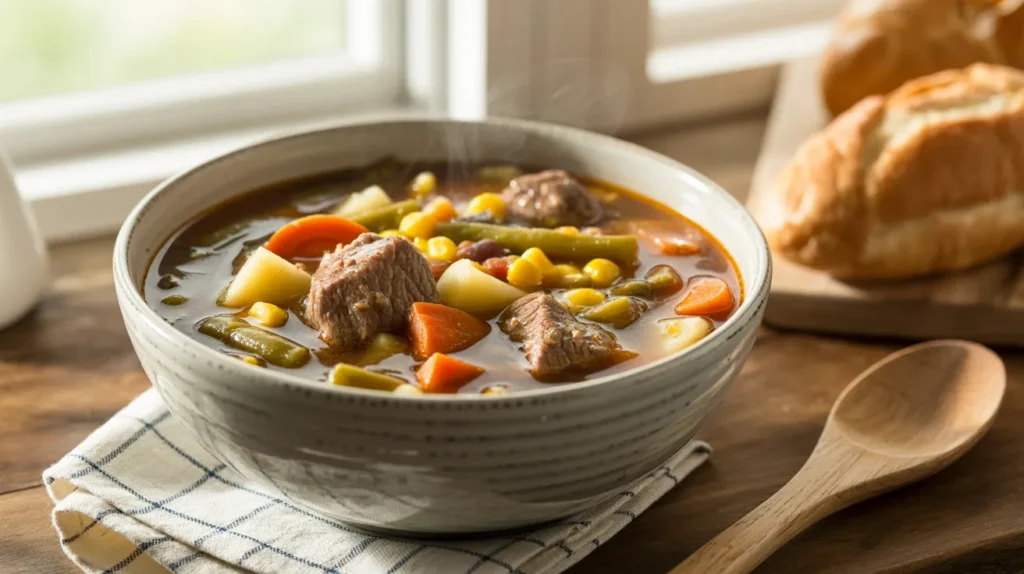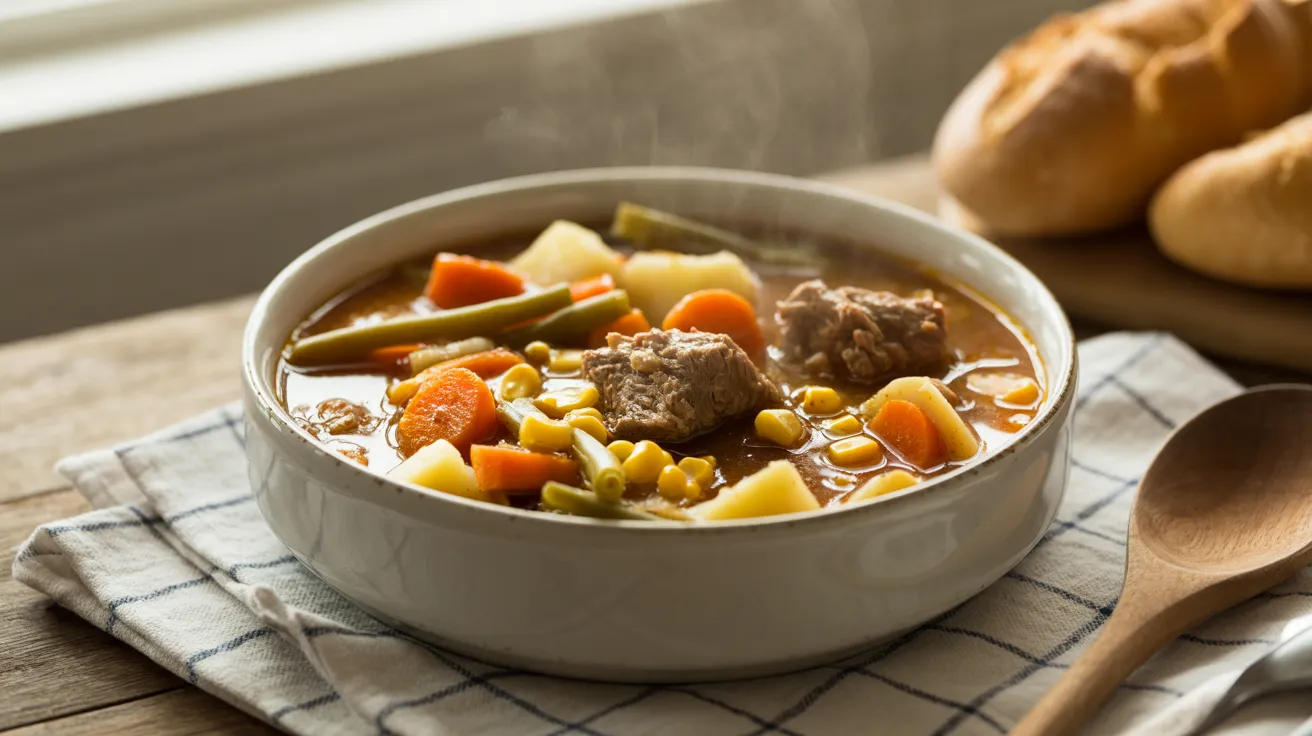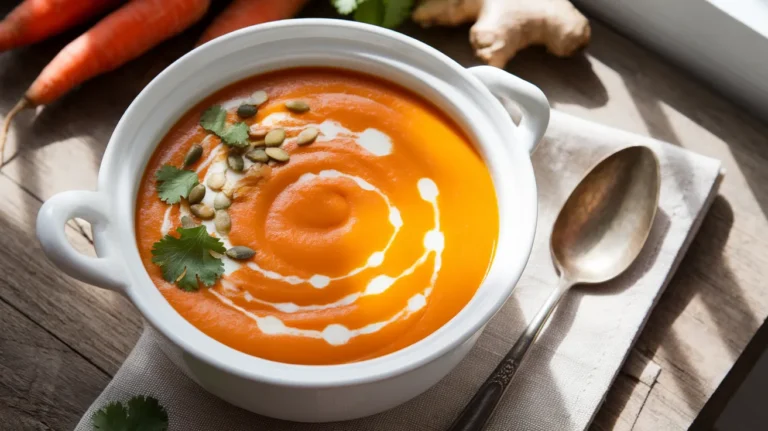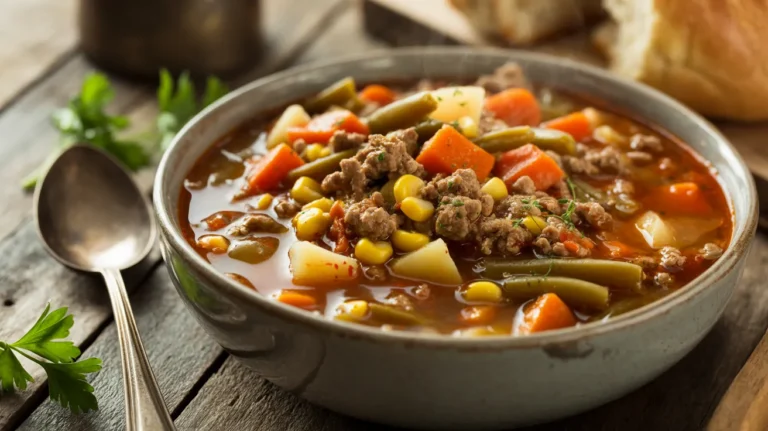This hearty vegetable beef soup brings together tender chunks of beef with vibrant fresh vegetables in a rich, savory broth that tastes like it simmered all day. Our foolproof vegetable beef soup recipe transforms simple ingredients into a soul-warming meal that’s perfect for busy weeknights when you need something satisfying and nutritious on the table fast.
SERVES: 4 | PREP: 20 MIN | COOK: 25 MIN | TOTAL: 45 MIN
Ingredients for Perfect Vegetable Beef Soup
Protein & Base
| Ingredient | Amount | Notes |
|---|---|---|
| Beef stew meat | 1 lb, cut into 1-inch cubes | Chuck roast works perfectly |
| Olive oil | 2 tablespoons | For browning the beef |
| Yellow onion | 1 large, diced | About 1 cup chopped |
Fresh Vegetables
| Ingredient | Amount | Notes |
|---|---|---|
| Carrots | 3 large, sliced | Cut into ½-inch rounds |
| Celery stalks | 3, chopped | Include some leaves for flavor |
| Potatoes | 2 medium, cubed | Yukon Gold or Russet work best |
| Green beans | 1 cup, trimmed | Fresh or frozen both work |
| Corn kernels | ¾ cup | Fresh, frozen, or canned |
| Garlic cloves | 3, minced | Fresh garlic is essential |
Broth & Seasonings
| Ingredient | Amount | Notes |
|---|---|---|
| Beef broth | 6 cups | Low-sodium preferred |
| Diced tomatoes | 1 can (14.5 oz) | Fire-roasted adds depth |
| Tomato paste | 2 tablespoons | Creates rich base |
| Bay leaves | 2 | Remove before serving |
| Dried thyme | 1 teaspoon | Or 1 tablespoon fresh |
| Salt | 1 teaspoon | Adjust to taste |
| Black pepper | ½ teaspoon | Freshly ground |
| Worcestershire sauce | 1 tablespoon | Secret flavor booster |
Detailed Step-by-Step Instructions for Vegetable Beef Soup
Phase 1: Preparing and Browning the Beef (10 minutes)
Step 1: Prep Your Beef Properly
Remove the beef stew meat from refrigerator 15 minutes before cooking to bring to room temperature. Using paper towels, pat each piece completely dry on all sides. Why this matters: Wet meat steams instead of browning, and you’ll miss out on the deep, rich flavor that makes this vegetable beef soup special.
Step 2: Season the Meat Generously
Place dried beef cubes in a large bowl. Sprinkle 1 teaspoon salt and ½ teaspoon black pepper over the meat. Toss with your hands to coat every piece evenly. Let seasoned beef sit for 5 minutes. Beginner tip: Don’t be shy with seasoning – the salt helps create a better crust when browning.
Step 3: Heat Your Cooking Oil
Place a large Dutch oven or heavy-bottomed pot (at least 6-quart capacity) over medium-high heat. Add 2 tablespoons olive oil and swirl to coat the bottom. Heat until the oil shimmers and moves easily when you tilt the pan, about 2 minutes. Temperature check: The oil should be hot but not smoking.
Step 4: Brown the Beef in Batches
Add half the seasoned beef cubes to the hot oil, making sure pieces don’t touch each other. Critical mistake to avoid: Don’t overcrowd the pan or the meat will steam instead of brown. Cook undisturbed for 3-4 minutes until a golden-brown crust forms on the bottom.
Step 5: Flip and Continue Browning
Using tongs, flip each piece of beef to another unbrowned side. Cook for another 2-3 minutes until that side develops a golden crust. What you’re looking for: Rich, caramelized brown color on at least two sides of each piece.
Step 6: Remove First Batch and Repeat
Transfer browned beef to a clean plate and set aside. Don’t worry – the meat won’t be fully cooked through yet; it will finish cooking in the soup. Repeat the browning process with remaining beef cubes. Total browning time: About 8-10 minutes for all the beef.
Phase 2: Building the Aromatic Base (7 minutes)
Step 7: Use Those Delicious Drippings
With all beef removed, look at the bottom of your pot. You should see golden-brown bits stuck to the bottom – these are flavor gold! Reduce heat to medium and add 1 large diced onion directly to the same pot with all those drippings.
Step 8: Cook the Onions Until Softened
Stir the onions constantly with a wooden spoon for 3-4 minutes. The onions will release moisture that helps loosen those browned bits from the pot bottom. What to watch for: Onions should become translucent and fragrant, and the pot bottom should look cleaner as you stir.
Step 9: Add Garlic and Tomato Paste
Push onions to one side of the pot and add 3 minced garlic cloves and 2 tablespoons tomato paste to the empty space. Cook for 30-45 seconds, stirring constantly. Beginner warning: Garlic burns quickly, so don’t walk away during this step!
Step 10: Deglaze for Maximum Flavor
Pour ½ cup of the beef broth into the pot and immediately start scraping the bottom with your wooden spoon. Magic happening: You’ll see those browned bits dissolve into the liquid, creating incredible flavor for your vegetable beef soup. Stir until the bottom of the pot is completely clean.
Phase 3: Building Your Vegetable Beef Soup Base (15 minutes)
Step 11: Add Liquids and Seasonings
Return all the browned beef to the pot along with any accumulated juices from the plate. Add remaining 5½ cups beef broth, 1 can diced tomatoes (including the juice), 2 bay leaves, 1 teaspoon dried thyme, and 1 tablespoon Worcestershire sauce. Stir everything together.
Step 12: Bring to a Proper Simmer
Increase heat to medium-high and bring the mixture to a rolling boil, which should take about 3-4 minutes. Watch carefully – once you see big bubbles breaking the surface, immediately reduce heat to medium-low. You want a gentle simmer with just small bubbles occasionally breaking the surface.
Step 13: Simmer the Beef Until Tender
Cover the pot partially (leave about a 1-inch gap for steam to escape) and simmer for 10 minutes. Check occasionally by stirring gently. The beef should start becoming fork-tender. Timing note: Different cuts of beef may need 5-10 minutes longer, so test a piece with a fork.
Step 14: Add Root Vegetables First
Add 3 sliced carrots and 3 chopped celery stalks to the simmering soup. These vegetables take longer to cook than others, so they go in first. Stir gently to distribute evenly. Why this order matters: Adding vegetables by cooking time prevents some from getting mushy while others stay raw.
Step 15: Cook Until Vegetables Begin Softening
Continue simmering uncovered for 8 minutes, stirring occasionally. Test for doneness: Pierce a carrot piece with a fork – it should go in easily but the carrot should still hold its shape. The celery should be crisp-tender, not soft.
Phase 4: Adding Final Vegetables to Complete Your Vegetable Beef Soup (8 minutes)
Step 16: Add Potatoes for Heartiness
Stir in 2 cubed medium potatoes and continue simmering for 6 minutes. Potato prep tip: Cut potatoes into ¾-inch cubes so they cook evenly and don’t fall apart. Timing check: Potatoes should be fork-tender but not mushy when done.
Step 17: Add Quick-Cooking Vegetables
Add 1 cup trimmed green beans and ¾ cup corn kernels to the pot. These vegetables cook quickly and should retain some texture in your finished vegetable beef soup. Stir gently to distribute.
Step 18: Final Cooking and Seasoning
Simmer for 3-4 minutes more until green beans are bright green and crisp-tender. Taste test: Remove a spoonful of broth, let it cool slightly, and taste. Add more salt and pepper as needed – the soup should taste well-seasoned but not salty.
Step 19: Final Touches Before Serving
Remove and discard the bay leaves – they’ve done their job flavoring the soup. Turn off heat and let the soup rest for 2-3 minutes. Why wait: This brief rest allows flavors to meld and prevents burning your tongue on the first spoonful.
Step 20: Serve Your Perfect Vegetable Beef Soup
Ladle the hot soup into bowls, making sure each serving gets a good mix of beef, vegetables, and broth. Serving suggestion: Garnish with fresh chopped parsley or serve with crusty bread for a complete meal.
Professional Chef’s Notes for Vegetable Beef Soup
Beef Selection Secret: Choose chuck roast or stew meat with some marbling for the most flavorful vegetable beef soup. These cuts become incredibly tender during cooking and won’t dry out like lean cuts.
Vegetable Timing Strategy: The key to perfect vegetable beef soup is adding ingredients in the right order. Root vegetables need more time, while corn and green beans cook quickly and can become mushy if overcooked.
Broth Enhancement Technique: The combination of beef broth, tomatoes, and proper browning creates layers of flavor that make this vegetable beef soup taste like it simmered for hours instead of minutes.
Make-Ahead Advantage: This vegetable beef soup actually tastes better the next day as flavors continue to develop overnight. Store covered in the refrigerator for up to 4 days.
Nutrition Information (Per Serving)
- Calories: 285
- Protein: 28g
- Carbohydrates: 22g
- Fat: 9g
- Fiber: 4g
- Sodium: 680mg
Creative Vegetable Beef Soup Variations
Southwestern Vegetable Beef Soup: Transform your soup by adding 1 cup black beans, 1 diced bell pepper, and 1 teaspoon cumin for a Tex-Mex twist that brings exciting heat and flavor.
Mediterranean Style: Include ½ cup diced zucchini, ¼ cup fresh basil, and 2 tablespoons balsamic vinegar for Italian-inspired flavors. This pairs beautifully with recipes like our French Onion Beef Short Rib Soup for a complete comfort meal experience.
Asian Fusion Vegetable Beef Soup: Add 1 tablespoon soy sauce, 1 teaspoon fresh ginger, and ½ cup snap peas for an East-meets-West experience similar to our popular Satay Beef Noodle Soup.
Hearty Winter Version: Double the potatoes and add 1 cup chopped cabbage plus ½ cup pearl barley for an extra-filling cold-weather meal that satisfies the biggest appetites.
Storage & Reheating Your Vegetable Beef Soup
Refrigerator Storage: Cool completely before transferring to airtight containers. Store for up to 4 days. The flavors actually improve overnight, making leftover vegetable beef soup even more delicious.
Freezer Storage: Freeze in portion-sized containers for up to 3 months. Leave 1-inch headspace for expansion. Pro tip: Potatoes may change texture when frozen, but the soup will still taste great.
Reheating Instructions: Thaw overnight if frozen. Reheat gently on stovetop over medium-low heat, stirring occasionally. Add extra broth if needed to thin consistency.
Meal Prep Strategy: Make a double batch of this vegetable beef soup recipe and freeze half for busy weeks when you need a quick, satisfying meal.

Troubleshooting Common Vegetable Beef Soup Problems
Problem: Beef is tough and chewy
Solution: Cut meat against the grain and simmer longer. Tough cuts need extra time to break down properly. Add more broth if needed and continue cooking.
Problem: Vegetables are mushy and overcooked
Solution: Add vegetables in stages based on cooking time needed. Don’t overcook tender vegetables like corn and green beans – they should retain some bite.
Problem: Vegetable beef soup tastes bland
Solution: Season in layers throughout cooking. Salt the beef, season the aromatics, and adjust at the end. Don’t skip the Worcestershire sauce – it’s a game-changer.
Problem: Broth is too thin and watery
Solution: Simmer uncovered to reduce liquid, or mix 2 tablespoons cornstarch with cold water and stir into simmering soup.
Problem: Soup is too salty
Solution: Add diced potatoes to absorb excess salt, dilute with additional unsalted broth, or add a splash of cream to balance flavors.
Essential Equipment for Making Vegetable Beef Soup
- Dutch oven or large heavy pot (6-quart minimum capacity)
- Sharp chef’s knife for efficient vegetable chopping
- Large cutting board (use separate boards for meat and vegetables)
- Wooden spoon for stirring and deglazing
- Measuring cups and spoons for accurate proportions
- Can opener for tomatoes and broth
- Tongs for handling hot meat pieces safely
Complete Shopping List for Vegetable Beef Soup
Meat Counter
- 1 lb beef stew meat or chuck roast (cut into cubes)
Produce Section
- 1 large yellow onion
- 3 large carrots
- 3 celery stalks (with leaves if possible)
- 2 medium potatoes (Yukon Gold or Russet)
- 1 cup fresh green beans
- 3 large garlic cloves
Pantry/Canned Goods
- 6 cups beef broth (low-sodium preferred)
- 1 can diced tomatoes (14.5 oz, fire-roasted if available)
- Small can tomato paste
- Olive oil
- Worcestershire sauce
- Bay leaves, dried thyme, salt, black pepper
Frozen Section (if needed)
- ¾ cup corn kernels (if not using fresh or canned)
Top 5 Success Secrets for Perfect Vegetable Beef Soup
1. Master the Browning Technique – Properly browning the beef creates the foundation flavor for your entire vegetable beef soup recipe. Don’t rush this crucial step.
2. Never Skip the Deglazing – Those browned bits stuck to the pot bottom contain concentrated flavor that transforms ordinary soup into something extraordinary.
3. Season in Strategic Layers – Salt the beef before browning, season the aromatics while cooking, and taste before final seasoning adjustment.
4. Control Your Heat Carefully – Maintain a gentle simmer throughout cooking to prevent vegetables from breaking apart and beef from becoming tough.
5. Taste and Adjust Constantly – The best vegetable beef soup comes from tasting and adjusting seasoning throughout the cooking process, not just at the end.
This comprehensive vegetable beef soup recipe delivers restaurant-quality results in under an hour, proving that homemade comfort food can be both simple and spectacular when you follow proper techniques.




